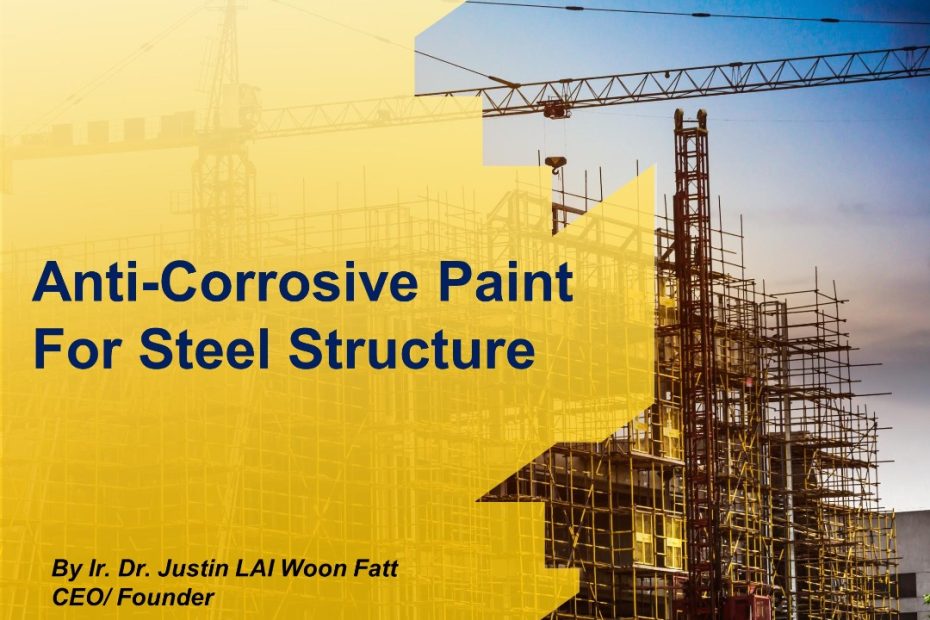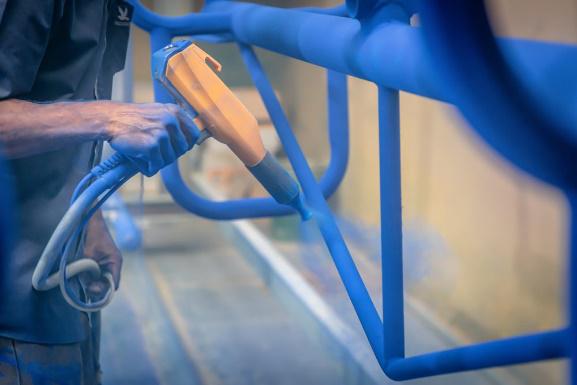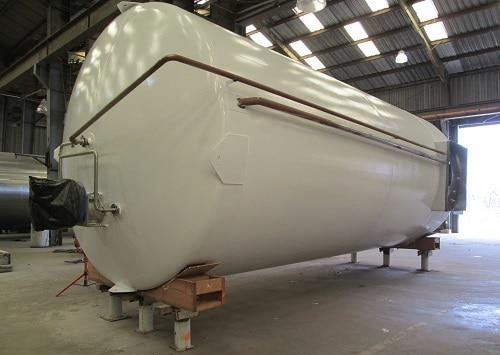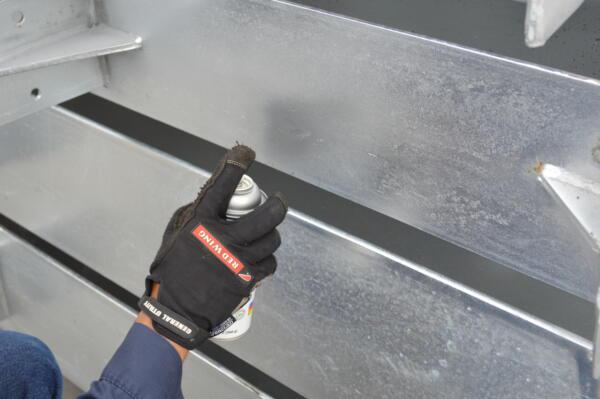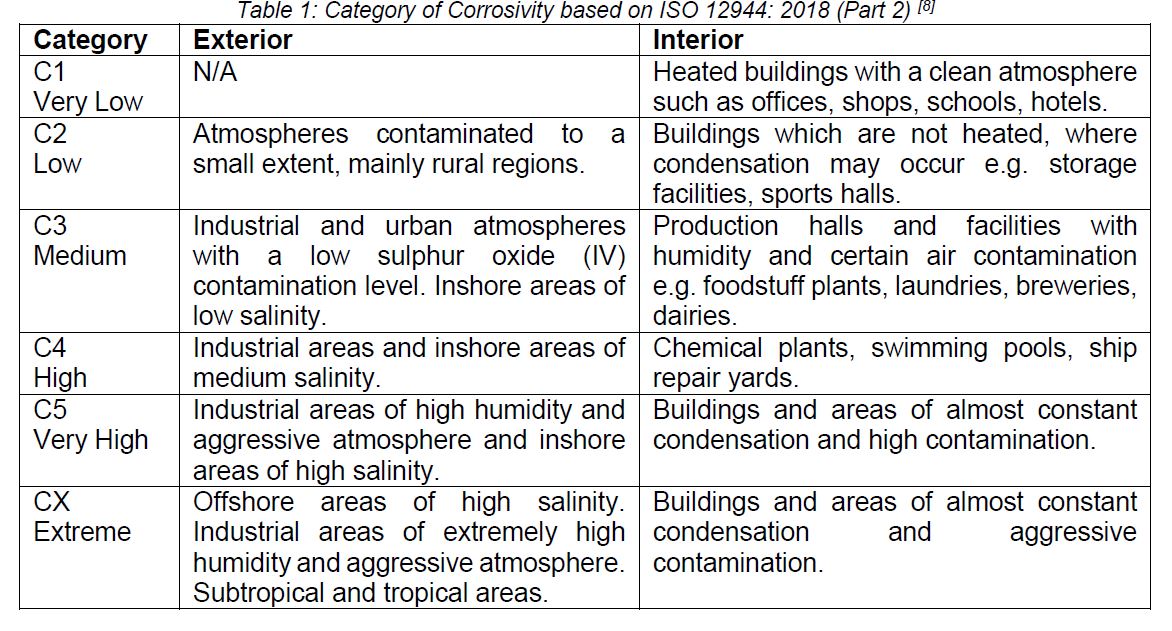Author: Ir. Dr. Justin LAI Woon Fatt | 29 October, 2022
INTRODUCTION
Steel is an irreplaceable material in the construction industry due to its excellent combination of strength and workability. It is used for beams, columns, roof trusses, gutters, etc. Besides buildings and infrastructures, steel is also used extensively in the manufacture of machines, weapons, and vehicles. However, steel is prone to corrosion if left unprotected, especially in chloride-laden environments.
Anti-corrosive paint is generally defined as a paint formulated with a corrosive-resistant pigment, and a chemical and moisture-resistant binder that can protect a steel component from corrosion. This type of paint forms a physical insulating barrier layer to prevent direct contact between the steel and its environment outside, thus preventing the occurrence and progression of corrosion.
COMPOSITION OF ANTI-CORROSIVE PAINT
Anti-corrosive paint consists of three major components:
- Corrosion resistant pigments
Some examples of corrosion-resistant pigments are zinc dust, lead chromate, zinc chromate, and red lead. Zinc dust is a zinc material in the form of a powder that imparts corrosion inhibiting properties. It is widely used to manufacture anti-corrosive paint. Due to the low solubility of zinc dust in the water, it can be applied on sea vessels and ships, offshore rigs, containers, and bridges. Red lead or lead (II, IV) Oxide is well known for its high adhesion and coverage, and long-term inhibiting action in combating corrosion. However, it has been phased out of use in many countries due to its toxic nature [1]. - Binder
Binders are the film-forming components of paint that determine its physical and chemical properties. Binders used in anti-corrosive paint are classified into two types: thermoset and thermoplastic. The difference between these two classes is that thermoset coating differs chemically from paint in a can, and it is not affected by solvents once cured. In thermoplastic coating, the dry film and wet paint differ only in solvent and are chemically identical [2]. Linseed oil, which is derived from flax seed, is frequently used as a binder in anti-corrosive paint. - Solvent
The solvent acts as a binder dissolver in anti-corrosive paint. It helps to reduce the viscosity of the paint to a level that is suitable for the various methods of application. For instance, brush, roller, conventional spray, airless spray, etc. After application, the solvent evaporates and plays no further part in the final paint film [3]. An example of solvent for anti-corrosive paint is thinner.
TYPES OF ANTI-CORROSIVE PAINT
Some of the anti-corrosive paints are [4]:
- Fluoropolymer paint
Fluoropolymer is a combination of high-performance resins and fluoropolymer lubricants. It can be used in environments with very high/ low temperatures. Besides having high resistance to corrosion and chemical, it has some degree of electrical resistance as well. This combination of traits makes it suitable for various types of fasteners. - Epoxy paint
Epoxy is a popular industrial coating made from epoxide resin and a polyamine hardener (catalyst). Some examples of epoxy paints include coal tar epoxy, amine epoxy, and polyamide epoxy. Epoxy paint is highly durable and corrosion resistant. As a result, it can be used to protect water transmission pipelines, steel pipes, and fittings in the oil and gas industry, and concrete reinforcing rebar in the construction industry from corrosion. - Inorganic zinc paint
Inorganic zinc paint is a type of paint with large amounts of zinc metallic dust mixed with a binder. It is effective against weathering and salt attacks, making it ideal for steel protection, especially in marine atmospheric environments. Inorganic zinc is compatible with a wide assortment of topcoats such as epoxies, phenolics, and silicones, thus further enhancing its corrosion protection.
PROPERTIES OF ANTI-CORROSIVE PAINT
A good anti-corrosive paint should have excellent performance in terms of long-lasting anti-corrosion protection and low maintenance. Also, it should have quick drying and hardening properties. Besides, some properties of anti-corrosive paint are weather protection against rain, salt water, ice, etc. It should also be good in resisting abrasion and fending off algae, moss, and fungi.
SELECTION OF ANTI-CORROSIVE PAINT
Matching a coating type to the substrate and the work environment it will apply to is crucial as the right coating can help to reduce corrosion, extend service life, and ease future maintenance. The corrosivity of certain environment has been classified and standardised by the International Organisation for Standardization. According to ISO 12944:2018 (Part 2), the degree of corrosivity is divided into 6 categories namely C1 to CX, in order of increasing corrosivity, based on the corrosion time of untreated zinc or carbon steel under various atmospheric conditions. Once the environment is identified, the right anti-corrosive paint specification can be selected to protect the steel component from corrosion attack. This helps to prevent overspending on unnecessary degrees of protection or simply making the wrong choice.
CONCLUSION
The scale-up of corrosion in a system can be prevented or at least minimized by utilizing anti-corrosive paint. It is important to enhance our knowledge, methodology, and application of anti-corrosive paints to help mitigate the negative effects of corrosion before our property whittles and rusts away. While consumer-grade steel is capable of developing rust after 4 to 5 days of exposure to rain, normal paint can protect steel structure for 2 years whereas anti-corrosive paint systems can give up to 15 years of protection for steel in the harshest condition if it is well applied [9][10]. Hence, when choosing an anti-corrosive paint, it is crucial to consider the type of corrosive environment, the composition, and the type of equipment subjected to corrosion exposure. Only then, corrosion can be tackled without additional cost.
Ir. Dr. Justin LAI Woon Fatt
CEO/ Founder
IPM Group
References:
[1] Brittney. (2021, December 1). Can you still use red lead paint? Art Radar Journal. Retrieved on 24th August 2022 from https://artradarjournal.com/2021/12/01/can-you-still-use-red-lead-paint/
[2] Seal Expert. (2017, June 12). Anti-corrosion Type and Their Applications. Retrieved on 24th August 2022 from https://www.sealxpert.com/anti-corrosion-coating-types-and-their-applications
[3] Edge Prop. (n.d.)Steel corrosion: Protect your property before it whittles and rusts away. Retrieved on 24th August 2022 from https://www.edgeprop.my/content/1901365/steel-corrosion-protect-your-property-it-whittles-and-rusts-away%E2%80%A6
[4] Kevin H. (2020, March 23). What are different types of anti-rust/ anti corrosion coatings? Performance Painting. Retrieved on 24th August 2022 from https://www.performance-painting.com/blog/what-are-different-types-of-anti-rust-anti-corrosion-coatings-
Jaydutt. (2017, August 12). Anti corrosive paint: All you need to know. Gharpedia. Retrieved on 24th August 2022 from https://gharpedia.com/blog/anti-corrosive-paint/
[5] Precision Coating Technology & Manufacturing (n.d.) 9 Frequently asked questions about fluoropolymer coating spray. Retrieved on 24th August 2022 from https://www.precisioncoatingtech.com/blog/9-frequently-asked-questions-about-fluoropolymer-coating-spray/
[6] Zwirner Equipment. (2016, September 27). Benefits of epoxy coating on metals. Retrieved on 24th August 2022 from https://www.zwirnerequipment.com/blog/benefits-epoxy-coatings/
[7] American Galvanizers Association. (n.d.) Zinc-rich paint. Retrieved on 24th August 2022 from https://galvanizeit.org/corrosion/corrosion-protection/zinc-coatings/zinc-rich-paint
[8] Kue. (n.d.) Corrosion classifications: What is ISO 1994? Retrieved on 24th August 2022 from https://www.kuegroup.com/corrosion-classifications/
[9] SML. (n.d.) What is the best paint to protect steel? Retrieved on 24th August 2022 from https://www.smlmarinepaints.co.uk/antirustpaint
[10] Kurt Gorman. (2021, March 16.) How long does it take metal to rust? 3 Clear answers. Retrieved on 24th August 2022 from https://rustconverters.net/how-long-does-it-take-metal-to-rust/
